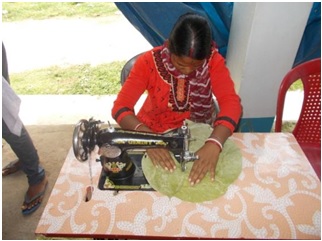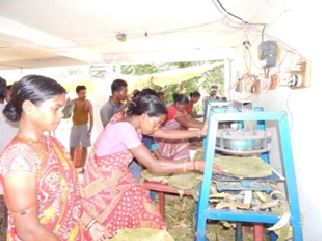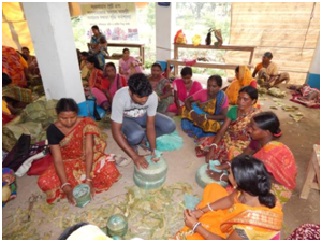TOTAL PROJECT COST-41.33,BANDWAN,YEAR-15-16
Background : Salpata is a major forest produce of the people residing in the districts of Purulia, Bankura, Birbhum and Paschim Medinipore. This natural forest produce is a major alternate livelihood opportunity for the marginalized tribal community but it is important to upgrade them with adequate skills and market linkage opportunities. Plates made of Sal leaves are used in huge numbers everyday, in all districts as well as in other cities and towns of West Bengal. These are very much preferred because they are easily disposable and perishable. Hotels, eateries, caterers purchase these plates from Burrabazar in Kolkata, which houses a big wholesale market. More than 1 Lakh pieces are sold from Burrabazar area alone. The businessmen mentioned that there is constant demand of these plates and more supply is needed. Even these plates are sourced by various Government canteens, lodges, guest houses to augment the marketability of the product. Diversified products can also be developed through Salpata which may also have a bigger market. But critical challenges are maintenance and small repairing of the moulding machine, knowledge of market, working capital support and motivation to take this livelihood option forward.
In the year 2015, West Bengal Khadi and Village Industries Board took up an unique intervention of augmenting livelihood of Salpata artists in the districts of Purulia, Bankura, Birbhum and Paschim Medinipur. Around 13000 beneficiaries have been involved in the project. In the first phase of intervention 5048 SHGs were trained in stitching, moulding and packaging. Seeing the success of the first phase, the project was extended further to the second phase where 371 SHGs were trained in stitching, moulding and packaging. Stitching and moulding machines are being provided to the SHGs trained. The SHGs are linked to various markets in Kolkata and capacity of SHG Federations like Aranya Sundari of Paschim Medinipur has been built to take up the same.
As part of hardware interventions a centre of excellence on Salpata is planned at Jhargram, Paschim Medinipur. The centre to be developed at Government land has already started. Initial design, planning is completed and leveling of land, dredging has already started. The entire centre will be managed and maintained by Aranya Sundari Mahila Mahasangha.
Seeing the success of the entire intervention and interest of other districts, it is proposed that the project may be extended to the district of Bardhaman in the two blocks of Ausgram II and Kanksa. A preliminary baseline of the beneficiaries has already been made and a list of 2073 beneficiaries has been made. Trainings to the individuals on stitching, moulding and packaging will be provided, linked to the market and stitching and moulding machines will be provided as hardware part. Feasibility of infrastructure development at Ausgram II, Kanksa or using existing structures will be assessed and taken forward.
Objectives :
- Augmenting livelihood of 2073 beneficiaries involved with Salpata in the two blocks of Ausgram II and Kanksa of Bardhaman district.
- Enhancing skills of the beneficiaries on stitching, moulding and packaging of Salpata leaves and bowls.
- Developing community enterprise on Sal leaf based product at Bardhaman.
Project Area : Bardhaman District, Blocks :Ausgram II and Kanksa
Gram Panchayats : Amarpur, Devsala, Valki of Ausgram II and Bidbihar, Molandighi, Kanksa, Bankati, Trilokchandrapur of Kanksa Block
Project Beneficiaries : A total of 2073 beneficiaries will be involved in the project covering 193 SHGs.
Activities :
Soft Intervention :
- Baseline survey to identify the artisans and analysing socio-economic situation of the target beneficiary communities. A preliminary study is already been conducted and the list is attached.
- Skill building workshops with the beneficiaries will be held on stitching, moulding, packaging and machine maintenance: A total of 13 trainings will be conducted at Bardhaman for skill building of the beneficiaries.
- Market Linkage activities for augmenting business of the sale leaf plate and bowl.
- Institution Building : Capacity building of the SHGs / clusters in taking up the business of Sal leaf plate and bowl.
- End line impact evaluation
Project Period : 6 months
Approach and Methodology of Training :
Technical trainings will be provided to the beneficiaries for learning sewing, moulding, packaging and machine maintenance.
Stitching Process: Steps being followed in teaching the sewing process of Sal leaf plates are:
- Practice of pedaling and hand movement: The session includes the process on how to operate the machines using hands and legs. This knowledge is the first step for learning sewing.

- Setting up bobbin and needle:This step introduces the process of reeling the thread into the bobbin and needle. Installing the bobbin into the bobbin case is also introduced during this training step.

- Movement of Sal leaf during sewing: Movement of the Sal leaf while stitching is an important part of the training without which the shape of the plate will be distorted. This step involves training on easy hand movement over the Sal leaf is during stitching.
- Proper stitching and quality check: In this session simultaneous and proper coordination of hands, legs and eyes is taught. This is the final step where the trainees learn to stitch keeping quality in mind.
Moulding Process: The following steps are being followed during the moulding training:
- Heat arrangement and control: Proper temperature of moulding machine is critical in the moulding process. This session introduces how much to heat the machine as the machine is electrically operated and imparts the knowledge of the proper temperature for moulding and temperature control to avoid overheating.
- Moulding of stitched Sal leaf plates: This session introduces the trainees to moulding plates (dice). It teaches the necessary pressure needed to bring out a perfectly moulded plate. Placing of plates in between the dice and extraction of moulded plates using a hook is also taught.
- Finishing & Quality Check: This session includes checking the finishing of the moulded plates and cutting off trims and loose thread using a knife.
Packaging Process: In this session the primary step is to cut a plastic roll in a measured length to wrap the bundle of plates. Bunches of 30 plates are made and

wrapped in the cut out plastic sheet. 10 such bunch of 30 plates each are finally packed in polythene sack. Thereafter these sacks are stitched and stored for transportation.
Hard Intervention :
Supply of machines : Stitching and moulding machines will be provided to the SHGs. Each of the 193 SHGs will be provided with 2 stitching machines and 1 moulding machine.
Feasibility of construction of a common facility centre at Ausgram / Kanksa will be assessed and will be taken up. Existing structures may also be renovated and developed into the CFC as per requirement.
Khadi and Village Industries Board will tender the work online and detailed drawing and estimate will be done by the KVIB Officials. Contact Base will depute a manpower for monitoring the on field construction activities and whether it is being done in conformity to the technical specification and satisfying need of the artisans. The land will be donated by the artisans / cooperative society and the same will be selected by Contact Base.
Facilities Provided: Soft Intervention, Hard Intervention, Skill Development and Product Diversification Training, distribution of 211 Nos. of Moulding 422 Nos. of Stitching Machine.(See the link...Impact Study...)






